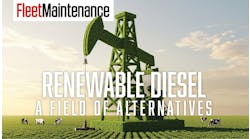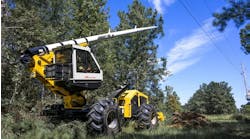Mark Hadley is a believer. When Hadley, director of maintenance for West Valley City, UT-based Central Refrigerated Service, Inc., spent a few minutes behind the wheel of a tractor equipped with Bendix Commercial Vehicle Systems' ESP Electronic Stability Program back in 2006, he knew immediately that he had to spec' all his new tractors with the innovative safety technology.
When Hadley received the invitation to Houghton, MI to attend a Bendix "Ride 'n' Drive" ESP demo, his response was an immediate "Heck, yea!" He was already interested in a rollover-prevention systems for his fleet, but the Bendix package intrigued him because it represented a full stability control system.
"I was extremely impressed, not only by the roll stability, but particularly when they went around the oval track," Hadley recalls. "They went around an oval track at 40 or 45 miles per hour, on ice. I could make the turns and everything just fine, but as soon as they flipped the system off, I was completely out of control. I had to slow down to about 20 miles per hour before I could even think about getting this vehicle back under control"
Hadley went back home to Utah with his mind made up: "I told Volvo that we would be the first ones on the bandwagon," he recalls. "In fact, I asked when it would be available and they said second quarter. Well, we already had our build of trucks going, and we insisted that we get that on as soon as it was available.
"You always think, 'never get the first of anything,' because you're going to get to deal with all the flaws," Hadley says. "Well, this thing was flawless right out of the gate, and it's been that way ever since."
YAW CONTROL
There's a big difference between roll only stability systems, sometimes called RSP or RSC, and full stability systems like ESP, according to Fred Andersky, marketing director, electronics, for Bendix Commercial Vehicle Systems. "The difference is that there are some additional sensors in a full stability system that measure both what the driver wants the vehicle to do, and what the vehicle is actually doing from a directional standpoint," he says.
"Obviously, we're using the wheel speed sensors from the ABS to provide information," Andersky continues. "But, we're also then using a lateral acceleration sensor that measures the side-to-side forces that would occur in a traditional rollover, and a yaw sensor, or directional stability sensor, that measures where the truck's going, and a steer angle sensor, in which the steering column goes through the sensor, so we can measure the driver's input."
That expanded sensor system is supported by additional braking capability: a roll only system will brake the drive and trailer axles, but a full stability system will selectively brake the drive, trailer and steer axles. "What that allows the system to do is not only help slow the vehicle down quickly, but also redirect the vehicle as necessary to get on the path on which the driver wants the vehicle to go," he says.
All of which meshed perfectly with Central Refrigerated's focus on safety. "We've had our little issues--brake valves and so forth--but as a whole, it's been a no-brainer," says Hadley. "So much so that Volvo went and put it on as a standard item in '07. The reliability was there right out of the gate, and we hit the ground running with it."
SAFETY FIRST
Many fleets would need a very clear and strong ROI calculation before investing in sophisticated safety technology for 1,850 tractors, but for Central Refrigerated, "payback" was not a driving factor in the decision to spec' ESP on its tractors. According to Hadley, the company's CEO believes that safety is its own reward, and so an investment like this is simply the right thing to do.
"Our CEO is all about safety," Hadley says. "He wants the best safety record in the country, for the health of our society and our drivers."
That allows Hadley and his spec'ing colleague a pretty free hand to get whatever technology they feel will make their trucks safer on the highway. A case in point concerns federal stopping distance requirements that will in all likelihood be mandated by the government. Not content to wait for "the Feds," Hadley attended a brake demo hosted by ArvinMeritor, and saw first-hand how to meet the future requirements today.
"We went to the 16 ½ x 5-inch brake in the front," he says. "Volvo went standard with that, but we were ahead by a year with that. We spec'ed it before Volvo spec'ed it."
And when he learned that, to meet the proposed stopping distance requirements, trucks would need both larger front drums and 8-5/8ths-inch brakes in the back, he modified his spec's again.
"We believe in the government's request that we stop these trucks quicker," he explains. "We're not going to wait until they mandate it; if it seems that it will be safer, then we're going to do it. That's our philosophy: if technology is there and it's reliable, we're going to grasp it. It's all about staying healthy as a company, and protecting the public and our drivers."
HAVING AN 'EVENT'
It's odd to think that a safety system is often most effective when the driver is unaware that it is working, but Hadley has found that to be the case with the Bendix ESP system. In the best of worlds, a driver won't know he has experienced an instability "event" until the home office tells him.
An early test of a trailer-only rollover-prevention system serves as an example. One of Central's trailers had to react as the truck it was paired with was going around a curve. "It actually gave the location of the event and the speed of the truck, " Hadley recalls. "We were able to contact the driver and say, 'Did you realize that on this corner, at this time of day, that the trailer actually had to intervene, because it was feeling unstable?' It was a real eye-opener for the driver; he was appreciative, and he wanted to know who was watching him!"
Why not tell the drivers straight out about ESP? "We figure what they don't know won't hurt them," Hadley explains. "We don't want knowledge of the system to affect their driving behavior--(driving too fast or too carelessly because they think the system will save them). We still want them to be in control of their truck."
Despite that precaution, Hadley believes that the stability system will make the fleet's drivers more confident over time.
"Whether they realize it's their ability or not, we won't tell them that, because we want them in control of their truck at all times," he says. "But again, the system is only there to intervene when they've already done their best, but it's not good enough, for whatever reason.
"Our accidents are starting to decline," he reports. "Can you attribute it to a lot of things? Yes, but it's certainly saving us somewhere... and (ESP) makes a good driver a really good driver."
ADDED COMPLEXITY?
If any aspect of stability control has given Hadley pause, it's the complexity issue. The idea of adding a new electronic system to already complex trucks caused some anxiety at Central's offices.
"There were a lot nay-sayers who said, 'What are you doing? Is it worth the money?'" recalls Hadley. "But, to the two of us who went there to spec' these trucks, it was a no-brainer."
In the end, that added complexity hasn't affected Central's maintenance practices at all. There are no special skills, tools or training required.
"If it fails, it's just like any other ABS system," Hadley says. "It's got fault codes and you can plug into it and diagnose it."
Bendix's Andersky points out that there are only two unique maintenance concerns with ESP. First, any front end alignment or front end work will require a recalibration of the steering angle sensor. "And that's really easily done with our Bendix ACom® diagnostic software," he says. "You plug the software into your computer and hook your computer through your RP1210 adapter into the truck. It'll take you through the steps and it adds about 10 minutes onto a front end alignment.
"The other case that comes into play for both roll and full stability systems is that we put the lateral acceleration and yaw rate sensor in a black box that's mounted on the frame rail, usually near the center of the tractor or of the truck," Andersky says. "If there's work done on the frame rail and that box has to be moved, it has to be replaced in the same orientation, and typically all the OEs build it so you can't put it on the wrong way. But then that has to be recalibrated, but that's rare. "
SAFER AND SAFER
"There are some companies I know, if they can't put an ROI on it, they don't get it," says Hadley. "When we came back here and talked to our CEO, we knew the cost had to be reasonable, and in our minds it was, but we didn't care about the ROI. We knew that if it saved us one rollover it would pay for itself. Could we quantify it? No. But we thought that, regardless, it's the safest thing out there to put on a truck, and it didn't need to be quantified."
And soon the safest thing out there will be even safer, as Central Refrigerated sync's up the fleet's ESP systems to a Qualcomm wireless communications network.
"Eventually we'll be able to contact the driver and tell him what has just happened," Hadley says. "'You just went into an event; did you realize that? No? Well, you need to slow down. You were on a curve and you were going too fast, and you didn't realize it but the brakes on your tractor were actually applying.'
"The drivers are amazed and grateful (for ESP)," Hadley says, "but not so shocked that they don't want the system on their vehicles."
As for the nay-sayers who originally objected to ESP? "We actually had to ship them to Houghton to see for themselves," Hadley says with great satisfaction. "They wanted the system off, because they felt that it wasn't doing anything; in fact, they thought it was making things worse. But they came back from Houghton and said, 'Uh, you know what?' In fact, someone showed them the technology for lane-departure systems and smart cruise control, and they came back and said, 'We should look at that, too.'"



